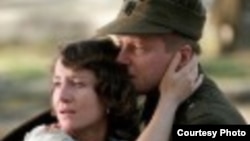"Katyn," a film by Polish veteran director Andrzej Wajda, may not be a masterpiece. But one year after its initial release in Poland -- and with audiences in places like the Czech Republic finding it in general release only now -- it is sure to embed itself in the minds of many viewers. If not for its artistic message, then at least for its stunning finale -- the massacre of Polish officers by the Soviet NKVD.
"Katyn" tells the story of the capture of some 20,000 Polish officers by the Red Army in September 1939, after Poland was nearly simultaneously attacked by Nazi Germany and the Soviet Union, and their execution in the spring of 1940 near the village of Katyn in Russia's Smolensk region and several other places.
The film's dramatic texture is woven around three war scenes.
There is a memorable opening scene on a bridge across the Bug River on September 17, 1939, where a group of Polish refugees fleeing the Wehrmacht meets another group of refugees heading to the west and fleeing the Red Army. One group tries to turn back the other in order to avoid the enemy. But which enemy is worse? Wajda finds a persuasive cinematic form and an apt metaphor for presenting Poland's political and existential dilemma at that time.
'You Must Endure'
The second war scene is a Christmas Eve supper in an Orthodox monastery, where Polish officers are held as POWs. An unnamed general addresses the fellow prisoners with the message: You must endure for the sake of a free Poland. The poignancy of the scene lies in the viewers' foreknowledge that these people will not endure to see Poland any longer, whether free or enslaved.
The final scene, that of the execution, which lasts for some 15 minutes, is almost unbearable to watch. Wajda and his cinematographer, Pawel Edelman, show the mechanics of killing the officers with horrifying precision and realism. This is perhaps the least metaphorical sequence of the entire film, which otherwise may appear too heavily overloaded with symbolic imagery. This is the sequence that arguably deserves a place in any anthology of the world's best cinematic accomplishments.
View the English-subtitled trailer for "Katyn."
The remainder of the film tells several interconnected stories -- set in Krakow under the Nazi occupation and shortly after its liberation by the Soviets -- of wives, mothers, and sisters of those imprisoned and subsequently executed at Katyn. It also tells the story of a Soviet lie about Katyn.
Following their invasion of the Soviet Union in 1941, the Germans discovered one of the three mass graves at Katyn, conducted an exhumation with the participation of Polish doctors, and published the so-called Katyn list with some names of those buried in the grave. But after the war the victorious Soviets blamed the Nazis for the Katyn massacre. This official lie was accepted not only be Poland's postwar communist government but also by the West -- at least until Alexander Solzhenitsyn told his story of the Stalin regime and the West lent ear. In a broader sense, the lie about Katyn became the glaring example of many other Soviet falsehoods that people in communist Poland had to accept in order to live without problems within their political system.
Regrettably, the Krakow-set episodes lack immediate realism and emotional appeal of the war scenes. The women left behind by the officers are depicted as symbols rather than living persons.
There are, for instance, two sisters of a lieutenant pilot killed at Katyn. Shortly after the war, one of the sisters orders a memorial plaque to organize a symbolic burial of her brother. The plague bears the real year of her brother's death -- 1940. The other sister, who works as a school principal, persuades her no to do that. Her argument is that one has to accept the reality that there will never be a free Poland. The defiant sister, who is subsequently arrested by the communist security service, not only repeats the gesture of Antigone from Sophocles' ancient drama but also Sophocles' lines in the conversation.
Personal, National Trauma
It is a pity that there are more episodes laden with this kind of theatricality and even didactic overtones in the film. Perhaps it was unavoidable, because Wajda faced a twofold task while making the film. He confronted not only his personal trauma -- his father was executed at Katyn -- but also a deep-rooted national trauma. He had to pay off his overdue debt to Polish history.
Thus, he certainly wanted to remind the Katyn tragedy to the younger generation, to include it in their national curriculum. "I know that the young generation, fully aware and with enthusiasm, is moving away from our past," Wajda says about "Katyn" in the director's statement. "Busy with mundane matters, they forget names and dates that, regardless of whether we want it or not, form us as a nation with its fears and misgivings surfacing at every political opportunity."
Second, he may have wanted the nation to see the Katyn tragedy "as it really happened" and to eventually overcome this trauma. Hence, the film is devoid of any scenes or subplots that might somewhat tarnish the collective national memory of innocent Polish suffering and death.
If these were actually Wajda's main objectives in making "Katyn," then they were fully achieved. The film premiered on September 17, 2007. It has been seen by nearly 3 millions Poles, which is an astounding figure in a country of 39 million. "Katyn" is among the top 10 best-attended films of the past 20 years in Poland.
One year later, it's difficult to tell whether its popularity in Poland -- combined with its nomination for a "Best Foreign Language Film" Oscar at the 2008 Academy Awards -- can translate into first-tier international success. For viewers unfamiliar with Polish history, "Katyn" may seem overly hermetic. The film has not yet found a distributor for audiences in the English-speaking world.
"Katyn" tells the story of the capture of some 20,000 Polish officers by the Red Army in September 1939, after Poland was nearly simultaneously attacked by Nazi Germany and the Soviet Union, and their execution in the spring of 1940 near the village of Katyn in Russia's Smolensk region and several other places.
The film's dramatic texture is woven around three war scenes.
There is a memorable opening scene on a bridge across the Bug River on September 17, 1939, where a group of Polish refugees fleeing the Wehrmacht meets another group of refugees heading to the west and fleeing the Red Army. One group tries to turn back the other in order to avoid the enemy. But which enemy is worse? Wajda finds a persuasive cinematic form and an apt metaphor for presenting Poland's political and existential dilemma at that time.
'You Must Endure'
The second war scene is a Christmas Eve supper in an Orthodox monastery, where Polish officers are held as POWs. An unnamed general addresses the fellow prisoners with the message: You must endure for the sake of a free Poland. The poignancy of the scene lies in the viewers' foreknowledge that these people will not endure to see Poland any longer, whether free or enslaved.
The final scene, that of the execution, which lasts for some 15 minutes, is almost unbearable to watch. Wajda and his cinematographer, Pawel Edelman, show the mechanics of killing the officers with horrifying precision and realism. This is perhaps the least metaphorical sequence of the entire film, which otherwise may appear too heavily overloaded with symbolic imagery. This is the sequence that arguably deserves a place in any anthology of the world's best cinematic accomplishments.
View the English-subtitled trailer for "Katyn."
The remainder of the film tells several interconnected stories -- set in Krakow under the Nazi occupation and shortly after its liberation by the Soviets -- of wives, mothers, and sisters of those imprisoned and subsequently executed at Katyn. It also tells the story of a Soviet lie about Katyn.
Following their invasion of the Soviet Union in 1941, the Germans discovered one of the three mass graves at Katyn, conducted an exhumation with the participation of Polish doctors, and published the so-called Katyn list with some names of those buried in the grave. But after the war the victorious Soviets blamed the Nazis for the Katyn massacre. This official lie was accepted not only be Poland's postwar communist government but also by the West -- at least until Alexander Solzhenitsyn told his story of the Stalin regime and the West lent ear. In a broader sense, the lie about Katyn became the glaring example of many other Soviet falsehoods that people in communist Poland had to accept in order to live without problems within their political system.
Regrettably, the Krakow-set episodes lack immediate realism and emotional appeal of the war scenes. The women left behind by the officers are depicted as symbols rather than living persons.
There are, for instance, two sisters of a lieutenant pilot killed at Katyn. Shortly after the war, one of the sisters orders a memorial plaque to organize a symbolic burial of her brother. The plague bears the real year of her brother's death -- 1940. The other sister, who works as a school principal, persuades her no to do that. Her argument is that one has to accept the reality that there will never be a free Poland. The defiant sister, who is subsequently arrested by the communist security service, not only repeats the gesture of Antigone from Sophocles' ancient drama but also Sophocles' lines in the conversation.
Personal, National Trauma
It is a pity that there are more episodes laden with this kind of theatricality and even didactic overtones in the film. Perhaps it was unavoidable, because Wajda faced a twofold task while making the film. He confronted not only his personal trauma -- his father was executed at Katyn -- but also a deep-rooted national trauma. He had to pay off his overdue debt to Polish history.
Thus, he certainly wanted to remind the Katyn tragedy to the younger generation, to include it in their national curriculum. "I know that the young generation, fully aware and with enthusiasm, is moving away from our past," Wajda says about "Katyn" in the director's statement. "Busy with mundane matters, they forget names and dates that, regardless of whether we want it or not, form us as a nation with its fears and misgivings surfacing at every political opportunity."
Second, he may have wanted the nation to see the Katyn tragedy "as it really happened" and to eventually overcome this trauma. Hence, the film is devoid of any scenes or subplots that might somewhat tarnish the collective national memory of innocent Polish suffering and death.
If these were actually Wajda's main objectives in making "Katyn," then they were fully achieved. The film premiered on September 17, 2007. It has been seen by nearly 3 millions Poles, which is an astounding figure in a country of 39 million. "Katyn" is among the top 10 best-attended films of the past 20 years in Poland.
One year later, it's difficult to tell whether its popularity in Poland -- combined with its nomination for a "Best Foreign Language Film" Oscar at the 2008 Academy Awards -- can translate into first-tier international success. For viewers unfamiliar with Polish history, "Katyn" may seem overly hermetic. The film has not yet found a distributor for audiences in the English-speaking world.





